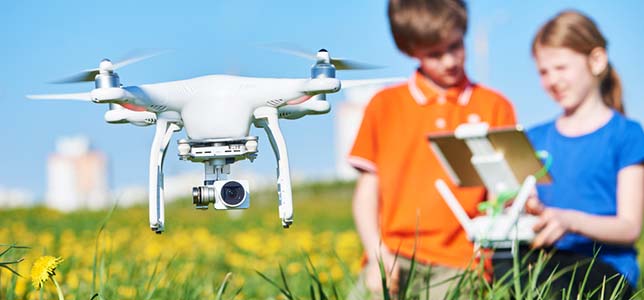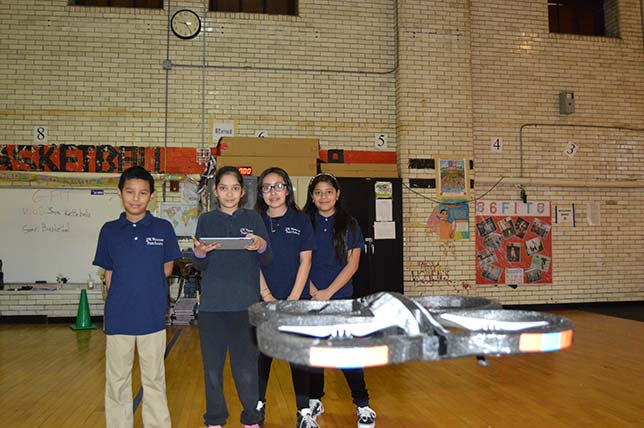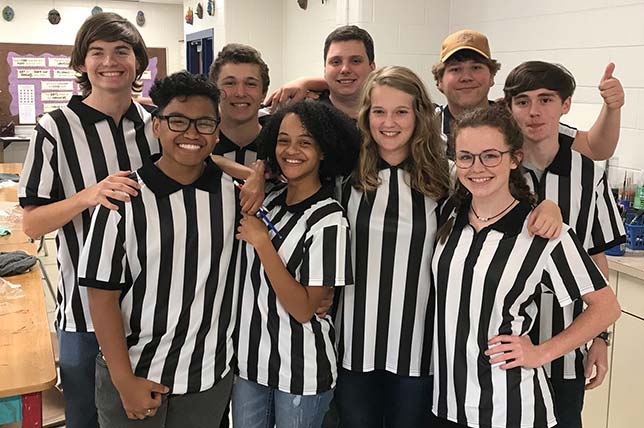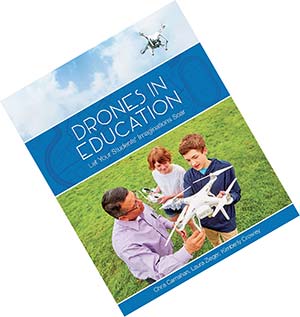Drones Take Off in Education
The use of this technology captivates students while allowing them to learn abstract concepts in off-the-ground ways.
- By Dian Schaffhauser
- 07/25/18

Unstaffed flying objects, unmanned aerial vehicles, remotely piloted aircraft. These are all alternative names for drones. According to two educators who have introduced them in the classroom, no matter what you call them, these small flying vehicles can be a useful response to drooping attendance, high discipline counts and low student satisfaction. Best, whether the subject is math, science, English, history, art or PE, there are drone lessons that can help bring abstract concepts to life for students.
As a K-8 math supervisor in Jersey City Public Schools, Kimberly Crowley wanted to figure out how to use drones to make math engaging for her students. Armed with a conviction that she could succeed, she got the backing of an associate superintendent who found funding to kick off the program for her to do a research project. Crowley held an information meeting and invited all of the schools in the district to send teachers who might be interested. This wasn't going to be a mandated program, she insisted. She shared her idea with the teachers in a 30-minute presentation and asked for volunteers. Out of 50 people in attendance, while a few "rolled eyes," another 24 emailed her as soon as she was done talking. They became her initial cohort.
All had committed to attending three days of professional development over the course of about three months (a day a month). The district purchased a single drone for each of the 14 schools, while she scrambled to find the money for some additional drones. And that was all it took, said Crowley. Now, out of the group she initially started with, all continue with their drone usage and purchase new drones each year to continue the lessons.
As a shift to more student-oriented elective classes, Long Cane Middle School Principal Chip Giles' district pursued an "Innovation Fund Tiny Grant" through a program run by the Georgia Governor's Office of Student Achievement. The proposal: "We were going to offer an entire course on drone technology." Most schools, he pointed out, "offer a unit, not a whole course." That grant, almost $9,000, purchased "a whole bunch of drones" and the materials to build a drone racing course.
With the help of Teacher Chris McCalla (@HeyMrMcCalla), the school got its drone program off the ground. "He's a hobbyist, and he drives race cars. He was exactly the right guy to do this. The kids really love him, and he has a lot of energy," said Giles, adding, "You need somebody on faculty who is very enthusiastic, likes to tinker and can fix broken drones, because we break them just about every day."

Jersey City Public Schools students fly drones indoors.
Choosing a Drone
Long Cane MS primarily uses the $55 UDI U818A-HD drone, which, according to Giles, is the "most widely sold drone in the world." Uniformity is important, he added, because that ensures that the league competitions started by the school will be won or lost based on "the skill of the pilot," and "not on whoever's parent can buy the coolest, fastest, best drone."
The school keeps about 200 on hand for its own courses and to have enough to share with other schools. All of the drones have cameras and are equipped with rotor guards that protect the propellers or blades. What's not needed is a GPS, insisted Crowley.
7 Drone Tips for Teachers
1. Seek help from educators who have already done what you're trying to do. For Long Cane MS, guidance came from experts at three higher-ed programs (the University of North Dakota, Kansas State Polytechnic and Troy University). Also, both Giles and Crowley make themselves available to confer with other schools and districts.
2. For students who struggle with flying the drones, consider outfitting them with tablets and a simulation app like QuadcopterFx so they can practice with that in between flight times. "Flight simulation is very cost-efficient," said Giles.
3. Drones don't need separate consoles. Nowadays, students are used to playing on games on smartphones and tablets, so they're just as comfortable using those as the control devices to fly drones, too, stressed Crowley.
4. Although Long Cane students wear safety glasses when they fly, drones are quite safe — "knock on wood" — insisted Crowley. "All the apps have emergency features. So you hit the button and it drops. The drone just lands, no matter where it is."
5. The thing about drones is that when they're flown outside, they tend to get lost or stuck in places that are inaccessible (trees, reservoirs, neighboring yards). Keeping extras on hand is important, as is not getting too riled up when they disappear.
6. Consider setting up a student drone repair team. At Long Cane, a team of interested students get together on a regular basis "in a little room with tools and broken drones," said Giles, "and they fix drones."
7. What's a substitute teacher supposed to do if he doesn't know how to fly drones? Giles recommended running YouTube drone videos, especially the ones showing crashes and accidents. "It's not that hard to entertain students for a day," he noted.
A primary variation with drones concerns the caliber of the camera. "You're not paying for a better drone — you're paying for a better camera," suggested Crowley. Jersey City PS started out with the low-cost AR drones sold by Parrot, which come with cameras. Those are still in use, three years later. But the district also has a few "paparazzi-caliber" drones outfitted with high-definition cameras that cost in the low four-figures.
Duration of battery is also an important consideration. In fact, Crowley advised that given the choice between buying a bunch of additional batteries and rechargers or buying a new drone, she'd go for the batteries. "They go fast," she said. For both school systems, drone battery life is limited to between six and 12 minutes per charge.
Accessing Lessons
Because lessons haven't traditionally existed covering drone use, both Giles and Crowley have been involved in creating their own. In Crowley's case, they were initially designed as math units to be used by the teachers in her research project. Many of the lessons appear on her research project's website, "Division B Drone Project" and cover the basics, including the standards to which it applies and ways to assess the students. However, once she finished with that initial cohort, she realized that restricting the drone usage strictly to math was unfair to the many educators asking her to help them get started with drones in their classes. As a result, those lessons show up in a book she co-wrote with two education colleagues. "Drones in Education" (see "The Book on Drones in Education") includes coverage not just for math but also social studies, science, language arts and an interdisciplinary mix (a study of the Underground Railroad), along with activities related to art, PE and journalism.
Long Cane PS, on the other hand, had an entire course to fill. The 45-day block of classes as an elective attended by students in grades 7 and 8 uses a "level system." "Everyone starts out at level 1," Giles explained. To get to level 2, students must pass a safety protocol test and a "basic drone comprehensive test," which includes history, aeronautics, drone components and drone laws. They must also do a basic flight performance test. To make it to level 3, the highest one, students need to go through 10 days of supervised drone flight practice, and they have to pass an advanced drone flight performance test, as well as a comprehensive test on ethics, law, careers and university opportunities. In other words, it's not just book learning; at least half of every class is spent flying, too. "If they're not flying drones every day, you're not doing what the kids want you to do," Giles warned. And most of the students do make it to level 3.

Long Crane Middle School students compete in aerial drone races.
Now the school is planning for a second course, Drone Tech II, which will use "more sophisticated devices" and add "first-person view" flying. "It's like you're sitting in the drone's cockpit. You see what it sees — like you're Han Solo in the Millennium Falcon flying," Giles marveled. "It's so much cooler to do."
Plus, his school has introduced a drone racing league, which has generated participation from other middle schools in the area. Students vie in two divisions. "Precision flying" takes place in a gym on a u-shaped course and requires students to maneuver drones through windows, land them on small tables and weave through a slalom. "Speed racing" happens on the football field. Four students at a time race their drones through PVC-built goals multiple times. So far Long Cane has dominated the podium. However, admitted Giles, a competing school that didn't show great flying at the beginning of the year had two pilots win first-place medals in the latest set of contests.
The Book on Drones in Education

Kimberly Crowley is one of three authors behind "Drones in Education," published by ISTE in 2016. The book includes case studies of teachers' use of drones, including in special education, safety and legal issues, how to choose and operate a drone, how to mesh it with state learning standards, how to implement the use of drones for active learning, and how to fund drone programs. The book also includes real-world applications and 10 sample lesson plans (with more online) that Crowley personally tested in classrooms. ($21.95 in paperback; $10.95 in digital format)
About Those FAA Regulations
Neither educator is overly concerned about federal drone regulations that have dogged professional and hobbyist drone pilots. First, said Crowley, a lot of drone flying can take place right inside the classroom, which isn't under the purview of the Federal Aviation Administration. Once the students take them outside, the rules get a bit stickier. However, any drone except the very cheapest ones come with a setting to configure the maximum altitude. Set it to 10 feet, and it'll work in a classroom; set it to 20, and it'll work in a gym; set it 30 feet, and the students will still be able to keep their eyes on it.
And unless the school is within five miles of an airport or in the vicinity of an emergency situation, its use will fall under the "special rule for model aircraft." One caveat offered by Crowley to her teachers is not to fly the devices outside personally; leave that to the students. Because they're "paid" as teachers, they're no longer considered hobbyists (unless they request a waiver from the FAA).
Better Attendance, Less Discipline
The impact of drones shouldn't be underestimated, said Crowley. For example, one teacher within her district has a K-2 class of students with autism. Crowley worked with the teacher to introduce drone flying to them. Once they were proficient, second grade general education students came in to learn from them. As a result, a dialog was opened up between the students with the disabilities and the others that they wouldn't have had otherwise. The drone initiative helped her students create friendships.
Likewise, Giles has seen a dramatic uplift in student motivation at his school. "They will get up and come to school if there's a course here they don't want to miss. "Our attendance has improved. Our referrals have probably dropped almost in half. And student satisfaction has gone way up," he asserted. As he observed, there aren't many technologies in use today in school that can promise those kinds of results.
About the Author
Dian Schaffhauser is a former senior contributing editor for 1105 Media's education publications THE Journal, Campus Technology and Spaces4Learning.